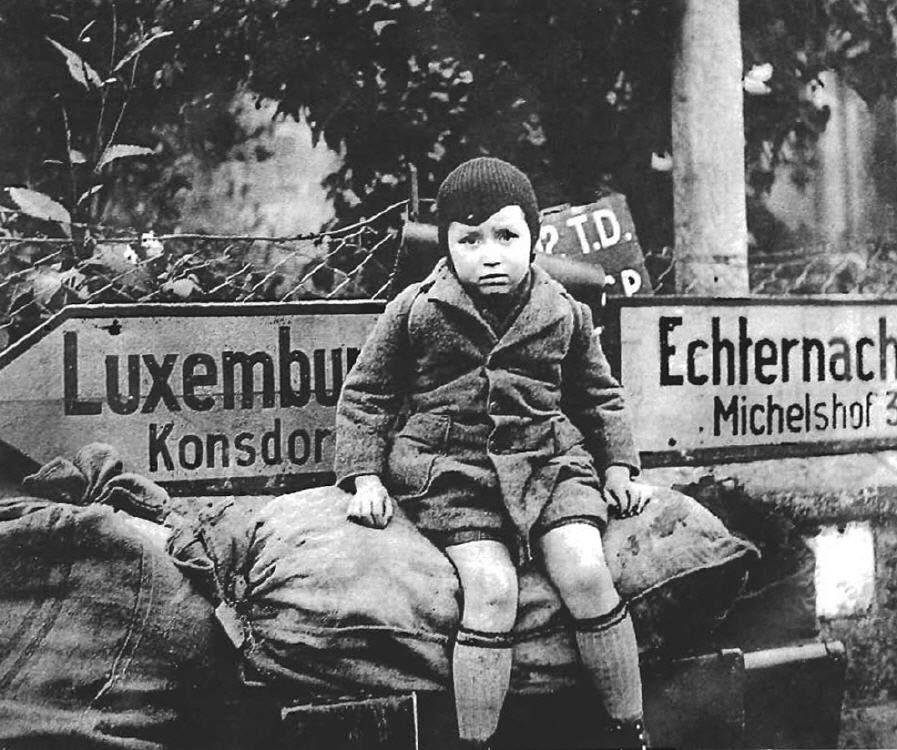
World War II: Luxembourg--Battle of the Bulge (December 1944- January 1945)

Figure 1.--Here civilians from northern Luxembourg are fleeing the Germans in the opening phase of the Battle of the Bulge, probably on December 17. Echternach fell to the Germans on the firt day of the German attack. Many of the civilians were taken in by the people of Herborn. Luxembourg City remained in American hands and Gen. Patton would established the Third Army headquarrs there. The Grand Duchy would have to be liberated by the Americans a third time. Photographer: Lee Miller.
|
|
The Germans lauched their second Ardennes offensive, surprising the Americans by coming out from behind the defenses of the West Wall (December 16, 1944). I would be the final German offensive of the War. They struck through the densely forested Ardennes region of Wallonia (Belgium), France, and Luxembourg. which became known as the Battle of the Bulge,Luxembourg would prove to be on the southern flank of the Bulge. The German Seventh Army, severly battered in France, was commanded by General Erich Brandenberger was assigned the southern zone of the offensive. The southernmost point on the pre-attack battlefront was near the Luxembourg town of Echternach in northern Luxembourg. The Seventh Army's assigned task was to protecting the southern flank of the drive toward Antwerp. The Seventth Army consisted of only four infantry divisions with no important armored units to suppor ther operations. Germany's dwimdling resources could not fully supply the units Hitler through into the battle. As a result, the Sevent Army did not penetrate deeply into Allied lines, unlike the armored formations to the north. Heavy fighting began in the woods around Echternach. The primary battle fought in Luxembourg at the onset of the battle was the Battle of Clervaux (Clerf) (December16-19). Clervaux was fought in northern Luxembourg. Units of the German 7th Army encircled surprised American forces from the 110th Regiment and the 109th Field Artillery Battalion. After heavy fighting with supplies running low, the Americans surrendered. Some authors refere to this as the Luxembourg 'Alamo'. Refugees from Echternach and Clervaux who manages to flee were taken in by the people of Herborn. General Patton moved his Third Army from the Saar in heavy snow and ice covered roads to attack the southern flank of the German offensive, this meant Luxembourg and the surround American forces in Bastogne. Heavy fighting ensued. The initial focus was on Bastogne in Belgium whichwas was releaved (December 24). Southern Luxembourg and Luxembourg City rmained i Allied hands. The city of Luxembourg served as Gen. Patton's Third Army. Slowly the Third Army began hammering the shoulders of the Bulge, meaning Luxembourg. The Americans could have launched pincer movements to have cut off the Germans in the Bulge. The southern pincer would have moved through Luxembourg. A shaken Genetral Eisenhower decided on a safrer broad-front drive. Thus it would be weeks before Luxembourg was liberated. The Americans retook Clervaux (January 25). The last Luxembourg town to be liberated was Vianden (February 12).
CIH -- WW II

Navigate the CIH World War II Section:
[Return to Main World War II Battle of the Bulge page]
[Return to Main Luxembourg World War II page]
[Return to Main World War II country pages]
[Return to Main World War II displaced children page]
[About Us]
[Biographies]
[Campaigns]
[Children]
[Countries]
[Deciding factors]
[Diplomacy]
[Geo-political crisis]
[Economics]
[Home front]
[Intelligence]
[POWs]
[Resistance]
[Race]
[Refugees]
[Technology]
[Totalitarian powers]
[Bibliographies]
[Contributions]
[FAQs]
[Images]
[Links]
[Registration]
[Tools]
[Return to Main World War II page]
[Return to Main war essay page]
[Return to CIH Home page]
Created: 7:35 PM 5/22/2015
Last updated: 7:35 PM 5/22/2015



